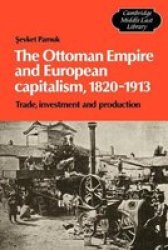Description
The book examines the consequences of the nineteenth century economic penetration of Europe into the Ottoman Empire. Professor Pamuk makes subtle use of a very wide range of sources encompassing the statistics of most of the European countries and Ottoman records not previously tapped for this purpose. His economic and quantitative analysis established the long-term trends of Ottoman foreign trade and European investment in the Empire. The later chapters focus on the commercialisation of agriculture and the decline as well as the resistance of handicrafts. Geographically, most of the volume focuses on the area within the 1911 borders of the Empire - Turkey, northern Greece, Greater Syria and Iraq. Professor Pamuk compares the relationship of the Ottoman Empire to the world economy with that of other parts of the non-European world and concludes that the two distinguishing features of the Ottoman case were the environment of Great Power rivalry and the ability of the government to react against European pressures.
Originally published in 1987, this book examines the consequences of the nineteenth-century economic penetration of Europe into the Ottoman Empire. Professor Pamuk makes subtle use of a very wide range of sources encompassing the statistics of most of the European countries and Ottoman records not previously tapped for this purpose. His economic and quantitative analysis established the long-term trends of Ottoman foreign trade and European investment in the Empire. The later chapters focus on the commercialisation of agriculture and the decline as well as the resistance of handicrafts. Geographically, most of the volume focuses on the area within the 1911 borders of the Empire - Turkey, northern Greece, Greater Syria and Iraq. Professor Pamuk compares the relationship of the Ottoman Empire to the world economy with that of other parts of the non-European world and concludes that the two distinguishing features of the Ottoman case were the environment of Great Power rivalry and the ability of the government to react against European pressures.
